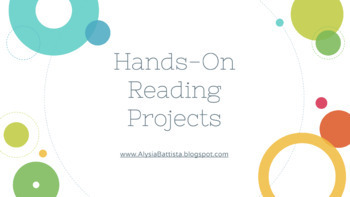Hands-on Reading Projects
Miss B Busy Bee
404 Followers
Grade Levels
3rd - 12th
Subjects
Resource Type
Standards
CCSSRL.3.2
CCSSRL.3.3
CCSSRL.3.10
CCSSRL.4.2
CCSSRL.4.3
Formats Included
- Google Slides™
Pages
19 pages
Miss B Busy Bee
404 Followers

Made for Google Drive™
This resource can be used by students on Google Drive or Google Classroom. To access this resource, you’ll need to allow TPT to add it to your Google Drive. See our FAQ and Privacy Policy for more information.
Description
Looking for some hands-on reading projects for intermediate, middle, and high school grades? These engaging ideas include templates, examples, and explanations for students to show what they know. They can all be done on paper or digitally!
Projects include:
-Diorama
-Triorama
-Character Interview
-Scrapbook page
-Movie poster
-Newspaper
-Yearbook page
-Timeline / Plot diagram
-Diary entry
-Travel map
-Song Scenes
-Foldable book
-Pop-up book
-Cell phone dialogue
-Play
-Comic
Students can be given the ability to choose between projects or all students can complete the same project with different books.
#projectbasedlearning #PBL #remotelearning #distancelearning
Total Pages
19 pages
Answer Key
N/A
Teaching Duration
N/A
Report this resource to TPT
Reported resources will be reviewed by our team. Report this resource to let us know if this resource violates TPT’s content guidelines.
Standards
to see state-specific standards (only available in the US).
CCSSRL.3.2
Recount stories, including fables, folktales, and myths from diverse cultures; determine the central message, lesson, or moral and explain how it is conveyed through key details in the text.
CCSSRL.3.3
Describe characters in a story (e.g., their traits, motivations, or feelings) and explain how their actions contribute to the sequence of events.
CCSSRL.3.10
By the end of the year, read and comprehend literature, including stories, dramas, and poetry, at the high end of the grades 2–3 text complexity band independently and proficiently.
CCSSRL.4.2
Determine a theme of a story, drama, or poem from details in the text; summarize the text.
CCSSRL.4.3
Describe in depth a character, setting, or event in a story or drama, drawing on specific details in the text (e.g., a character’s thoughts, words, or actions).




